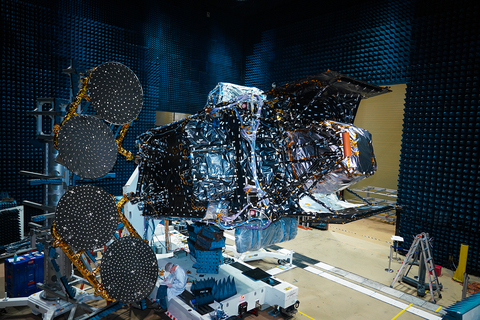Intelsat To Operate Air Pollution Monitoring Space Instrument
Intelsat To Operate Air Pollution Monitoring Space Instrument
NASA and Smithsonian Astrophysical Observatory are innovating to improve air quality in North America
MCLEAN, Va.--(BUSINESS WIRE)--Intelsat, operator of one of the world’s largest integrated satellite and terrestrial networks and leading provider of inflight connectivity (IFC), completed testing of the operational and data collection system for the first space-based instrument to monitor major air pollutants across the North American continent every daylight hour at high resolution. The new UV-visible spectrometer, operated by Intelsat for NASA and the Smithsonian Astrophysical Observatory, will be hosted on the Intelsat 40e (IS-40e) satellite set for launch next month.
Known as TEMPO (Tropospheric Emissions: Monitoring of Pollution), the mission of the instrument is to create a revolutionary new dataset of atmospheric chemistry measurements from space. TEMPO data will play an important role in scientific studies of phenomena such as rush-hour pollution and the movement of emissions from forest fires and volcanoes. Scientists could eventually apply TEMPO observations to air quality alerts for people in pollution hot spots and those living with health issues.
“Working closely with our partners, we successfully completed a rigorous schedule of tests to ensure that commanding, telemetry, and mission data are flowing accurately and at near real-time speed from the IS-40e satellite through the Intelsat ground system to the Smithsonian and NASA scientists,” said Jean-Luc Froeliger, Intelsat’s Senior VP of Space Systems. “The Intelsat communications and ground system is crucial to the success of the TEMPO project, and we’re prepared for the start of TEMPO operations this summer.”
The satellite and instrument will be positioned at 91 West in a geostationary orbit (GEO) about 22,000 miles above Earth's equator. This vantage point will enable TEMPO to monitor daily variations in ozone, nitrogen dioxide, and other key elements of air pollution from the Atlantic to the Pacific, and from Mexico City and the Yucatan Peninsula to the Canadian oil sands.
When TEMPO commences operations, the scientists at the Smithsonian Astrophysical Observatory (SAO) will send commands through the Intelsat custom-built software to the instrument and instruct it on where to scan and during what times. The instrument sweeps across North America on an hourly basis and makes observations during the daylight hours. The raw data from the observations will be transmitted back down to the Intelsat Riverside, Calif, ground station and then made available for the SAO scientists for access and analysis.
TEMPO will also form part of a virtual constellation of air pollution monitors that will give global scientists a big-picture view of air quality around the Northern Hemisphere. South Korea's Geostationary Environment Monitoring Spectrometer (GEMS) instrument rocketed into space on the Korean Aerospace Research Institute GEO-KOMPSAT-2B satellite. To complete the constellation, the European Space Agency Sentinel-4 satellite will make measurements over Europe and North Africa.
About Intelsat
Intelsat’s global team of professionals is focused on providing seamless and secure, satellite-based communications to government, NGO and commercial customers through the company’s next-generation global network and managed services. Bridging the digital divide by operating one of the world’s largest and most advanced satellite fleet and connectivity infrastructures, Intelsat enables people and their tools to speak over oceans, see across continents and listen through the skies to communicate, cooperate and coexist. Since its founding six decades ago, the company has been synonymous with satellite-industry “firsts” in service to its customers and the planet. Leaning on a legacy of innovation and focusing on addressing a new generation of challenges Intelsat team members now have their sights on the “next firsts” in space as they disrupt the field and lead in the digital transformation of the industry.
Follow Us on Social Media:
Twitter | LinkedIn | Facebook | Instagram | YouTube
Contacts
Steve Lott – Steven.Lott@intelsat.com; +1 202-285-9590

